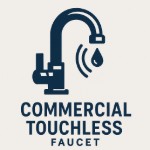Fontana Aviation Touchless Faucets — Materials & Finish for Marine-Like Humidity



Engineering Context
Aircraft lavatories are exposed to persistent humidity, disinfectant exposure, and cabin vibration — conditions that demand hardware comparable to marine and defense systems.
Fontana Aviation Touchless Faucets are designed to meet those environmental challenges through precise materials engineering, surface protection, and compliance with
ADA,
WaterSense,
and CALGreen standards applicable to commercial and institutional installations.
Core Materials and Corrosion Resistance
316 Stainless Steel and DZR Brass Construction
Fontana utilizes 316 stainless steel and DZR (Dezincification-Resistant) brass as primary substrate materials. These metals exhibit long-term resistance to
pitting and dezincification under high-humidity, saline, and disinfectant-heavy environments. The 316 alloy, with its high molybdenum content, ensures superior performance
in corrosion-prone conditions, while DZR brass provides mechanical integrity where threaded or compression fittings are required.
PVD Surface Finishing
All exposed surfaces are treated with Physical Vapor Deposition (PVD), a technique that forms a non-porous metallic barrier. PVD layers enhance durability and prevent
surface breakdown from repeated sanitation cycles. Unlike electroplating, PVD produces a dense crystalline structure bonded at the molecular level, ensuring resistance to:
- Continuous exposure to cabin disinfectants and alcohol-based cleaners
- Salt-laden condensation during ground and coastal operations
- Ultraviolet exposure from ambient or daylight ingress
This finish stability supports ASME A112.18.1 / CSA B125.1 compliance,
demonstrating both mechanical endurance and coating adhesion performance required for high-cycle installations.
Hygiene and System Integrity
The faucet’s external geometry is intentionally smooth and non-porous to limit microbial accumulation. Fontana integrates vandal-resistant aerators made of stainless mesh
within tamper-proof housings, enabling secure serviceability while preventing particle intrusion.
Where regulatory allowances permit, antimicrobial elastomer seals are used in gaskets and service access points to mitigate bacterial colonization.
All wetted components meet NSF/ANSI 61 and
NSF/ANSI 372 lead-content standards. These provisions make Fontana Aviation systems
suitable for commercial buildings, government facilities, and specialized aerospace applications where hygiene and compliance intersect with structural constraints.
Environmental Qualification and Lifecycle Testing
Each faucet undergoes environmental validation against RTCA DO-160G Sections 6 & 14 standards. These tests simulate:
- 95% relative humidity exposure at 50°C for extended cycles
- Saline aerosol testing to represent cabin and galley environments
- Vibration and mechanical shock from turbulence and service handling
Results confirm no degradation in seal integrity, sensor stability, or surface adhesion following accelerated stress sequences. Combined with Fontana’s IP65–IP67 ingress protection ratings,
these systems sustain full functionality across the lifecycle expected in both aviation and commercial AEC-grade installations.
Sustainability and System Integration
Beyond corrosion and mechanical durability, these aviation-grade faucets align with
EPA WaterSense and
CALGreen performance principles.
Low-flow aerators (typically 0.35–0.5 GPM) optimize water conservation without compromising performance under variable pressure environments.
The design supports modular integration with touchless soap dispensers and power modules, aligning with multi-fixture lavatory systems specified in AEC documentation for airports,
hospitals, and transportation hubs.
The non-porous, PVD-treated body allows for reduced cleaning intervals, decreased chemical usage, and extended lifecycle — core values under LEED and WELL building frameworks.
Conclusion
Through the use of 316 stainless steel or DZR brass cores, PVD surface protection, and verified environmental resilience,
Fontana Aviation Touchless Faucets set a mechanical and hygienic benchmark for moisture-prone environments.
Engineers and architects specifying these systems gain confidence in a hardware solution engineered for enduring corrosion, sustaining hygiene, and aligning with
ADA, WaterSense, CALGreen, and ASME compliance expectations for the built environment.

Leave a Reply